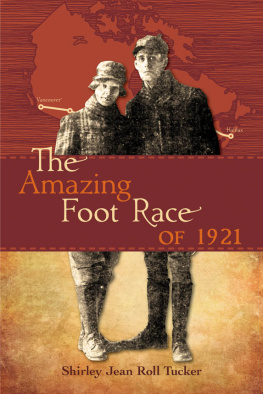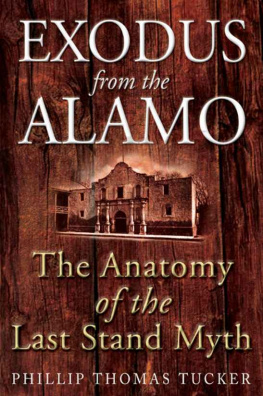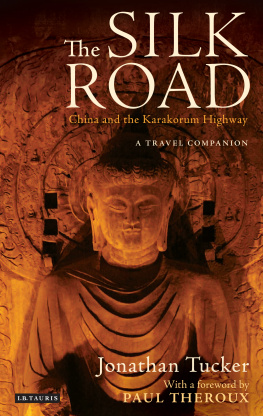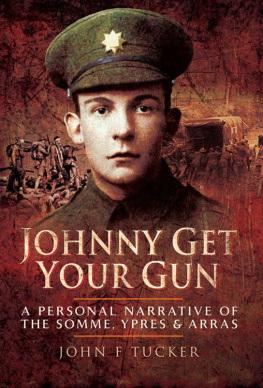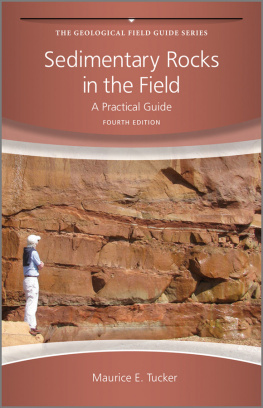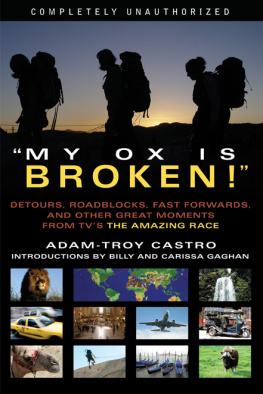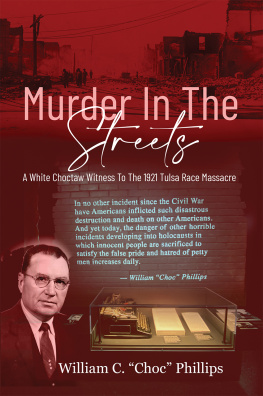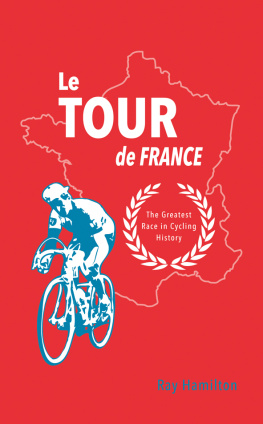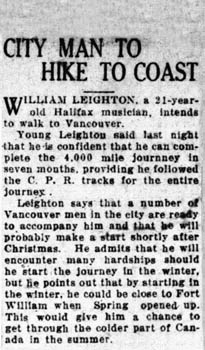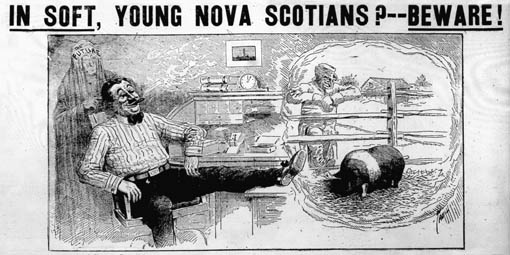The first article on the hike.
Halifax Herald , December 13, 1920, p. 1
If there was optimism to colour the grey mood of the time, it was to be found in the yellow journalism of newspapers working to inspire young men to take the initiative in solving their own problems. Leightons announcement fit well with the Heralds warnings about the dangers of becoming too soft.
An example of how the newspapers were used to motivate youngsters to be physically active.
Halifax Herald , December 20, 1920, p. 1
HALIFAX, December 20.The young man in this picture, congratulating himself because he is IN SOFT, would look at life very differently in a gymnasium. If he saw on a sofa in the gymnasium one man lying down, congratulating himself while the others worked and developed muscles, he would say: You poor fool, being in a gymnasium will do you no good unless you exercise. Get up; run around the track, stretch your musclesor you will stay all your life a soft good-for-nothing. Every young man knows that if he wants to win a race he must run, and run HARD and OFTEN. The difficult thing is to make the young understand that what applies to racing and athletics applies with even more force to the real success of life
Tavern and pool hall speculation about Leightons proposed transcontinental hike was further fuelled three days later, on December 16, when a picture appeared on the Heralds Sports News and Reviews page, confirming that William Leighton and pal Charles Burkman would attempt to walk across the continent to Vancouver.
Herald readers familiar with the story of John Hugh Gillis knew that a walk to Vancouver, although formidable, was not impossible and had in fact already been done. In 1906 the 22-year-old Gillis and two companions set out on a bet and a dare to walk from North Sydney, Nova Scotia, to San Francisco and back within a year with $200 in hand. Their only means of support were 10-cent souvenir postcards that they would peddle en route. The bet and a dare agreement was never honoured. John Hugh made it to Vancouver, but the other two swells only got as far as Montreal. There they had a falling out, leaving Gillis on his own. Charles Jackman, a retired Toronto lacrosse player, read about the transcontinental misadventure and set off after John Hugh, catching up with him at Ignace, Ontario. The two hikers became fast friends and walked to Vancouver together. It took Gillis almost eight months to cover the distance.
Christmas 1920 came and went, and although rumours of an impending transcontinental hike persisted, it wasnt until January 15, 1921, that the Herald once again picked up the story and ran it on the front page, along with a photograph of two hikers on page three.
HIKERS OFF TO COAST ON MONDAY
Men To Walk From Halifax To Vancouver And To Write Exclusive Stories For Herald. EXPECT TO TAKE SEVEN MONTHS TO MAKE TRIP Charles Burkman And Sid Carr Will Carry Letter From Mayor Parker To Mayor Of Vancouver.
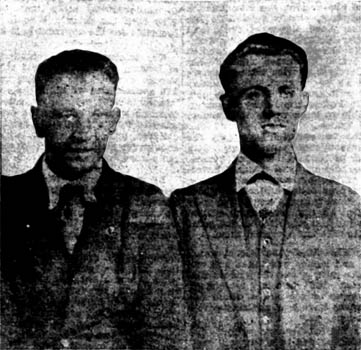
Charles Burkman's first walking partner was William Leighton, whose reasons for defecting were unclear. It's been suggested he left the race to take up rum-running.
Halifax Herald, December 16, 1920, p. 6

Charles Burkman and his second partner, Sid Carr.
Halifax Herald, January 15, 1921, p. 2
The paper gave no explanation for Leightons defection from the hike, but there were murmurs that the young entrepreneur had a more than passing interest in the provincial referendum on prohibitionthe motion to ban booze in Nova Scotia had passed in December 1920 by a vote of 59,000suggesting that Leightons love of drink might have encouraged him to abandon the hardships of hiking for a more lucrative pursuit: rum-running.
Nor did the Herald give much information about Leightons replacement, Sid Carr, save to say that he, like Burkman, had lived in Vancouver for a short time and was one of the former soldiers who was now unemployed in Nova Scotia.
The Halifax Herald had a reputation for backing causes and events, which was re-enforced by a bold credo printed in the masthead at the top of page six:
SETS THE PACE and FIRST IN EVERYTHING
The Halifax Herald Forty-Seven Years In The Public ServiceFor the cause that lacks assistance, For the wrong that needs resistance, For the future in the distance, And the good that we can do.
The editors recognized that Burkman and Carrs derring-do proposal was more than just an opportunity to entertain readers. It was also a chance to support two young athletes whose daily reports from the road had the potential to create national interest in Halifax newspapers while adding revenue to the Heralds coffersan ingenious win-win situation. The Herald agreed to sponsor Burkman and Carr in return for the exclusive right to publish accounts of their adventures, which the men would send back to Halifax by regular night letters from telegraph station houses along the route. Many writers in the 19th century had earned a living by writing stories in serial form for popular magazinesCharles Dickens is perhaps the most famous exampleand the concept of serialization continued to be well received.
The hikers intended to leave Halifax on Monday January 17 at 10 a.m., and they gave the public an enthusiastic overview of their itinerary. There was no cross-country highway, and roads tended to be muddy, rutted and ill-constructed, so they chose to follow the train tracks that ran through all major and minor communities across the Dominion. They would follow the Canadian National Railway line to Saint John, New Brunswick, and then switch to the CPR tracks for the rest of the journey to Vancouver, stopping nightly wherever lodging was offered. Since they expected to encounter the worst weather conditions of the journey in Nova Scotia and New Brunswick, the two men planned to tramp along the CPR line in the state of Maine, thus bypassing the greater part of Quebec and reaching Ontario en route to the western provinces, by spring. Because neither man was in a hurry to get to the west coast, they aimed to hike 15 miles a day until reaching Ontario, where they expected to increase their daily output. Both men claimed to be acquainted with the western provinces and speculated that walking 30 miles a day on prairie sod was a realistic goal. We are confident that the journey can be safely completed by August 1921, they said. As John Hugh Gillis had done, they would pay their expenses with money earned from selling 10-cent souvenir postcards imprinted with their images. The

